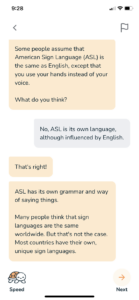This week I started my American Sign Language journey by exploring the ASL Bloom app. This was interesting because I discovered that you only have access to three courses before you are asked to register for an annual subscription. This was extremely disappointing because the app opens by saying that its intent is to share ASL with a larger audience. I did expect that they would want you to subscribe to open more courses at some point, however seeing the number of possible courses there are to take it is disheartening to know that they only allow you to access three of them for free. With all of that being said, I started my journey by taking the greetings course and I have really enjoyed it so far. My overall goal for this learning project was to be able to participate in an introductory conversation with someone using ASL. The two main phrases that I have learned in this course so far will be excellent conversations starters. I have learned how to sign “Hello, nice to meet you.” and “What is your name?”.
 One thing that I really enjoyed during my first course was that the course stops to share some background information about ASL. The goal was to express that ASL is not simply based on English, but is actually its very own language. I think that this was an important distinction to make because I do feel that people view sign language as an auxiliary communication channel of a more well known or “official” language. If you were to ask me to create a list of languages, sign language would not make the top five or even the top ten. Unfortunately, I tend to think of languages as needing to be spoken. I am not sure where this idea comes from, but I plan to do some more reflecting on this. I decided to do some research on the topic and found a blog post by Cindee Calton about the misconceptions of ASL. They mention that people believe that ASL is a series of gestures which would definitely explain the lack of recognition of ASL as a language. I do understand the need to clarify that ASL is a language as many people do not respect the depth of sign language. Recently someone that was supposed to be translating a press conference for the Tampa police department made a complete mockery of the language by not translating what so ever. To hire a sign language interpreter that does not have the ability to truly translate proves that the people that hired them did not take the necessary steps to ensure they had the proper credentials to be performing this task. I imagine that in the interview the interpreter signed a bunch of gibberish while lying about its meaning and was hired because people that do not use sign language believe that it is nothing more than a series of gestures. After learning more about these misconceptions I would love to amend my original goals for this learning project by adding that I would like to spread awareness and try to educate people on this issue.
One thing that I really enjoyed during my first course was that the course stops to share some background information about ASL. The goal was to express that ASL is not simply based on English, but is actually its very own language. I think that this was an important distinction to make because I do feel that people view sign language as an auxiliary communication channel of a more well known or “official” language. If you were to ask me to create a list of languages, sign language would not make the top five or even the top ten. Unfortunately, I tend to think of languages as needing to be spoken. I am not sure where this idea comes from, but I plan to do some more reflecting on this. I decided to do some research on the topic and found a blog post by Cindee Calton about the misconceptions of ASL. They mention that people believe that ASL is a series of gestures which would definitely explain the lack of recognition of ASL as a language. I do understand the need to clarify that ASL is a language as many people do not respect the depth of sign language. Recently someone that was supposed to be translating a press conference for the Tampa police department made a complete mockery of the language by not translating what so ever. To hire a sign language interpreter that does not have the ability to truly translate proves that the people that hired them did not take the necessary steps to ensure they had the proper credentials to be performing this task. I imagine that in the interview the interpreter signed a bunch of gibberish while lying about its meaning and was hired because people that do not use sign language believe that it is nothing more than a series of gestures. After learning more about these misconceptions I would love to amend my original goals for this learning project by adding that I would like to spread awareness and try to educate people on this issue.
One Comment
Kelsey Haas
Hey Karley!
I find ASL to be so interesting and I also never thought of it to be its own language. I’m not sure why but I just thought of it as like a part of English. I have been hearing more about ASL translators not actually translating the words properly which is so disappointing. It is great that you are wanting to bring more awareness to that!